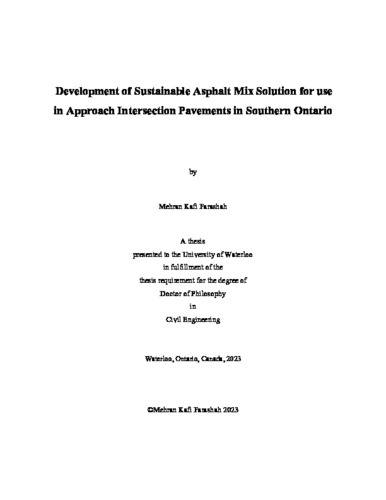UWSpace will be migrating to a new version of its software from July 29th to August 1st. UWSpace will be offline for all UW community members during this time.
Development of Sustainable Asphalt Mix Solution for use in Approach Intersection Pavements in Southern Ontario
| dc.contributor.author | Kafi Farashah, Mehran | |
| dc.date.accessioned | 2023-04-24 13:03:39 (GMT) | |
| dc.date.available | 2023-04-24 13:03:39 (GMT) | |
| dc.date.issued | 2023-04-24 | |
| dc.date.submitted | 2023-04-13 | |
| dc.identifier.uri | http://hdl.handle.net/10012/19313 | |
| dc.description.abstract | Due to the continuous rise in heavy truck traffic and the impacts of climate change, York Region is facing premature pavement failure at many of its heavy truck traffic intersections, primarily in the form of deformation or rutting. This implies that the pavement materials commonly used in the York Region for heavy truck traffic volume intersections may not meet desired resilience. As a result, the York Region selected six approach intersections for examination to assess their in-service performance and determine any need for material improvement. The findings from the field investigation revealed that rutting damage was only present in the asphalt surface layer, suggesting that the pavement structures were structurally sound, and the rutting was possibly caused by inadequate asphalt mix stability. In addition, three (3) currently specified plant-produced asphalt surface mixes by York Region were investigated to evaluate their rutting resistance: HMA-SP12.5 FC1 PG64-28, HMA-SP12.5 FC1 PG70-28, and WMA-SP12.5 FC2 PG70-28. The research used HWTT, Flow Number, IDEAL-RT, and a modified Uniaxial Shear Tester. Although the WMA-SP12.5 FC2 provided the best results, the conclusion was that the current asphalt mixes are not suitable for intersections with high traffic volume due to inadequate rutting resistance. The results from both field investigation and laboratory tests on plant-produced asphalt surface mixes indicated that relying solely on volumetric design may not fully reflect the mix's performance under heavy traffic. It is advised to incorporate performance testing in the design stage for a more comprehensive understanding of the mix's rutting resistance and desired reliability. The intend of this research was to propose a sustainable asphalt surface mix for the heavy truck traffic approach intersections in Southern Ontario, aimed at improving its resilience to rutting and cracking through performance testing. Therefore, a total of seven lab-produced asphalt surface mixes including six SMA and one EME asphalt mixes were investigated. The SMA mixes were produced by using two Nominal Maximum Aggregate Sizes (NMAS), 9.5mm and 12.5mm, and three polymer-modified asphalt binders, namely PG70-28, PG76-28, and PG82-28. The EME mix was produced with a 12.5mm NMAS and PG82-28 asphalt binder. In addition, HWTT, IDEAL-RT, Flow Number, and Dynamic Modulus tests were conducted to evaluate the shear resistance of asphalt mixes. Moreover, I-FIT and IDEAL-CT tests were applied to determine the intermediate temperature cracking resistance. While the DC(T) test was employed to evaluate the low-temperature cracking resistance. Furthermore, BPT and TSR tests were conducted to investigate the friction and moisture susceptibility of asphalt mixes, respectively. To establish performance specifications for evaluating the resistance of asphalt surface mixes to rutting and cracking at approach intersections with high truck volume in Southern Ontario, the results of the HWTT, IDEAL-CT, I-FIT, and DC(T) tests on seven proposed heavy-duty asphalt mixes were analyzed. The proposed preliminary specifications stated that the HWTT test should be performed at a temperature of 58°C and with 40,000 wheel-track passes. Furthermore, it was suggested that the rut depth acceptance threshold be reduced from 12.5mm to 6mm to address safety concerns at approach intersections. Based on the study data, a pre-determined threshold DC(T) fracture energy value of 900 J/m2 can be used. Additionally, it was recommended that the Flexibility Index (FI) value be set at 20 and the CT Index value at 500 for the heavy-duty asphalt mixes. The overall ranking based on the results of the HWTT, I-FIT, DC(T), and IDEAL-CT tests indicated that the best performing lab-produced asphalt mix was SMA12.5-PG76-28. The results of the life cycle analysis demonstrated a substantial increase in the service life of the pavement, leading to both material and cost savings when using the SMA12.5-PG76-28 asphalt mix in comparison to a currently specified asphalt mix in the York Region. | en |
| dc.language.iso | en | en |
| dc.publisher | University of Waterloo | en |
| dc.subject | heavy-duty asphalt mix | en |
| dc.subject | approach intersection | en |
| dc.subject | rutting | en |
| dc.subject | cracking | en |
| dc.subject | balanced mix design | en |
| dc.subject | life cycle cost analysis | en |
| dc.title | Development of Sustainable Asphalt Mix Solution for use in Approach Intersection Pavements in Southern Ontario | en |
| dc.type | Doctoral Thesis | en |
| dc.pending | false | |
| uws-etd.degree.department | Civil and Environmental Engineering | en |
| uws-etd.degree.discipline | Civil Engineering | en |
| uws-etd.degree.grantor | University of Waterloo | en |
| uws-etd.degree | Doctor of Philosophy | en |
| uws-etd.embargo.terms | 0 | en |
| uws.contributor.advisor | Tighe, Susan | |
| uws.contributor.advisor | Baaj, Hassan | |
| uws.contributor.affiliation1 | Faculty of Engineering | en |
| uws.published.city | Waterloo | en |
| uws.published.country | Canada | en |
| uws.published.province | Ontario | en |
| uws.typeOfResource | Text | en |
| uws.peerReviewStatus | Unreviewed | en |
| uws.scholarLevel | Graduate | en |

